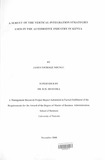| dc.description.abstract | Differences amongst competitor value chains are a key source of competitive advantage. The design of the vertical integration strategies is one way to distinguish the value chain of a strategic business unit from its competitors. In Kenya, there are a number of environmental factors that have affected negatively the motor vehicle industry. The market reforms that allow importation of used vehicles in Kenya coupled with the low purchasing power in the country has made the industry very competitive. Currently, used car imports account for 70% of the market. Consequently, the motor industry in Kenya must configure its value chain in a manner that ensures a successful competitive position.
The objective of this study was to establish the vertical integration strategies practised in the automotive industry and to identify the challenges associated with the strategies practised. A census survey was carried out on the new vehicle dealers (or franchise holders). Interviewer administered questionnaires were used to collect the data required. The data collected was analysed using measures of central tendency in order to provide a description of the trends in the industry with respect to vertical integration strategies. Content analysis was carried out to establish the challenges associated with vertical integration.
The design of vertical integration strategies practised in an industry can be distinguished by examining four dimensions namely; the stages, the breadth, the degree and the form of vertical integration. This study has described the industry in these four dimensions of vertical integration and has revealed the challenges associated with the practise of vertical integration strategies in the industry. The industry has raised four main issues that influence the crafting of its vertical integration strategies namely; assurance of quality, assurance of delivery, cost and ability to raise capital requirements. The industry can be said to have adopted vertical integration strategies that reflect a balance between the strategic benefits of vertical integration and the strategic costs of vertical integration. | en |

